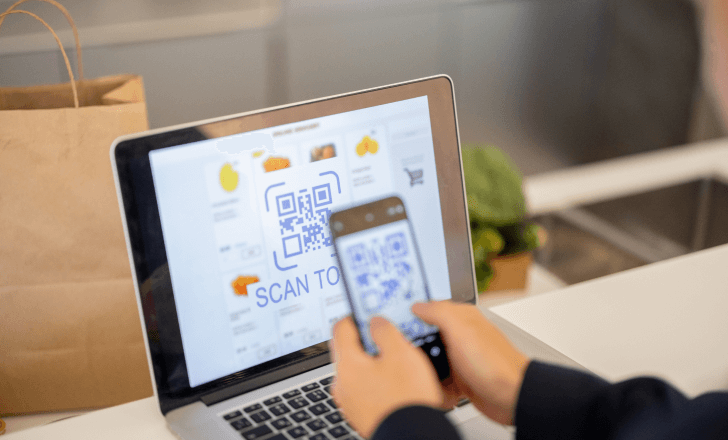What are QR codes?
A QR code, short for Quick Response code, is a type of matrix barcode that packs information—like text, URLs, or even multimedia—into a square pattern of black and white modules. Born in 1994 thanks to Masahiro Hara at Denso Wave, QR codes started out tracking car parts but quickly found fame beyond factories, thanks to their speed, flexibility, and ability to handle much more data than older barcodes.
Scanning a QR code is second nature now—just point your phone and snap to instantly open a website, pull up contact info, or play a video—no typing, no fuss. As mobile habits have evolved, QR codes on the web have become a familiar bridge between digital content and real-time interactions.
One reason QR codes are everywhere is their staying power. Static QR codes, once created, store information permanently and don’t expire. Plus, you can easily download a crisp QR code image in formats like JPG, PNG, or EPS, ensuring it looks sharp and scans reliably across different devices and platforms.

Benefits of using QR codes on websites
Increased engagement and interaction
Adding QR codes to your website isn’t just a trendy move—it’s a smart way to deepen engagement. With just a quick scan, visitors can access bonus content, exclusive offers, or helpful resources without extra clicks or typing. It keeps them curious and interacting longer, while also making social sharing practically frictionless—users can instantly pass along your content to friends or followers, expanding your reach with zero effort on your part.
Enhanced marketing and promotion capabilities
QR codes are powerful marketing tools when used strategically. Placed on your site, they can drive users straight to product pages, service details, event signups, or even purchases—no menu digging required.
And if you’re using dynamic QR codes, you unlock a deeper layer: the ability to update links anytime, track scan behavior, and gather performance data in real time. This lets you optimize campaigns with sharper targeting and better timing for stronger results.
Custom QR codes as avatars: Expanding possibilities
QR codes aren’t just for flyers and packaging—you can even turn them into your digital avatar. On platforms like LinkedIn or Twitter, where space is limited and first impressions matter, a custom QR code can act as a shortcut to the information you want people to see. Think of it as a mini portal to your résumé, video introduction, or online portfolio.
As long as the QR code is easy to scan and links to a mobile-friendly destination, it can boost your professional presence in a creative, memorable way. For anyone promoting services through a business website, adding a branded QR code avatar is a clever way to stand out and make connecting effortless.
Dynamic QR codes in web-based advertising: A closer look
At first glance, adding a QR code to a web ad—like a banner or Google Ad—might seem unnecessary. After all, users can just click the ad, right? But in practice, many people scroll past without interacting, especially when they’re focused on reading or watching something else.
That’s where dynamic QR codes can shift the game. Instead of requiring a click, a quick scan with a phone lets users instantly access the content—no extra tabs, no redirects, no disruption. And with modern devices, scanning a code directly from a screen is faster and easier than ever.
For marketers, it’s a simple tweak that can drive more engagement, recover missed opportunities, and offer a new layer of measurability in digital advertising.
Creating QR codes
Choosing a QR code generator
If you want a dynamic QR code that works seamlessly and reflects your brand, start with a reliable generator. While many free tools exist, not all offer the flexibility or tracking features needed for serious use.
QR Code KIT is a user-friendly option designed for both beginners and pros. Its free plan lets you create up to two dynamic QR codes—without expiration, ads, or hidden fees—making it ideal for testing new campaigns or building long-term assets.
Look for these features in any generator:
- Ease of use: You shouldn’t need a tutorial to get started.
- Data capacity: Whether it’s plain text or complex URLs, the tool should handle your content.
- Error correction: Built-in correction ensures the code still scans, even if slightly damaged.
- Cross-device compatibility: A good QR code must work smoothly across all mobile devices and apps.
Choosing the right platform sets the foundation for every scan that follows.

Customizing the QR code design and content
To boost both scan rates and brand recognition, design matters. With QR Code KIT, you can customize your QR code by adding your logo, adjusting colors, and aligning the look with your visual identity.
But it’s not just about aesthetics. You can also tailor the destination—whether it’s a landing page, YouTube video, Google Maps location, or downloadable file—to match the user’s intent and deliver a mobile-friendly experience.
A well-designed QR code builds credibility and increases interaction. And with QR Code KIT, you get full design control without needing to upgrade to a paid plan.
The enigma of QR codes on your website
Even though your visitors are already online, QR codes can offer powerful cross-device and multitasking benefits. At first, adding a QR code to your own website might seem strange—if visitors are already online, why would they need to scan anything? Why not just give them the information directly?
But QR codes on websites can serve some smart, specific purposes, especially when using a flexible platform like QR Code KIT, which lets you create free, dynamic QR codes with no signup or expiration.
Here’s where they can shine:
- Mobile bookmarking: A quick scan can save your site to a user’s phone for easy access later—great when switching from desktop to mobile.
- Launching multimedia: You can link to videos, PDFs, or image galleries without cluttering the page, offering smooth, on-demand experiences.
- App promotion: QR codes can point straight to your app’s listing in the App Store or Google Play, streamlining downloads.
- Interactive actions: Use QR codes as calls to action for email signups, surveys, or contact forms—no typing, just scan and go.
- Cross-device flow: Let users transfer content from one device to another instantly, especially useful for long forms, checkouts, or reading lists.
Used creatively, QR codes on your site can enhance the user experience, increase flexibility, and simplify actions that would otherwise take more effort.
QR code design and best practices
Adding logos and branding to QR codes
A custom QR code doesn’t just look better—it builds trust. By adding your logo or brand colors, users immediately recognize your company and are more likely to scan.
Just be sure your design doesn’t interfere with functionality:
- Use high-resolution logos that remain clear even when resized.
- Keep proportions balanced—a logo that’s too large can block the code, and one that’s too small won’t stand out.
- Stick to simple designs with limited colors to avoid clutter.
- Place your logo smartly, usually in the center, without covering essential scanning zones.
With QR Code KIT, you can design codes that match your brand and still scan perfectly.

Optimizing QR code size and resolution
Even the best design won’t matter if your QR code is too small or blurry to scan.
Follow these best practices:
- Minimum size: At least 1 x 1 inch (2.5 x 2.5 cm) for printed use.
- Resolution: Always export at 300 DPI or higher to maintain sharpness.
- Avoid screenshots: They often reduce clarity and can make the code unreadable.
A crisp, high-quality QR code ensures fast, frustration-free scans across devices.
Displaying QR codes in convenient locations
Where and how you place your QR codes directly affects scan rates.
Best practices include:
- Visibility: Place them in high-traffic or highly visible areas—both online and offline.
- Relevance: Position the code near the content or product it relates to, making the next step feel natural.
- Lighting and contrast: Make sure they’re not hidden in dark corners or against busy backgrounds.
- Field testing: Scan it yourself in context before going live—what works on screen may not work in the real world.
Strategic placement helps your QR code do its job: connect quickly, clearly, and effortlessly.
QR code usage and analytics
Importance of tracking QR code performance
If you’re using QR codes but not tracking their performance, you’re missing a huge part of the picture. Tracking tells you how often your codes are scanned, where, and when—and what users do next.
This kind of data is gold. It helps you understand what’s working, spot behavior patterns, and refine your marketing strategy. With a platform like QR Code KIT, you get built-in analytics that show scan rates, click-throughs, and conversions in real time—so you’re never guessing.
Using data to improve QR code campaigns
Once you start collecting data, it becomes your roadmap for smarter campaigns.
If a QR code in one location performs better than others, focus there. If more people engage after a content change, double down on that format. Over time, these insights help you fine-tune messaging, placement, and offers.
The result? More scans, better engagement, and measurable impact. Analytics turn your QR code from a simple tool into a performance-driven asset.

QR code campaigns and marketing
Creating successful QR code campaigns
A great QR code campaign starts with a clear goal. Are you driving traffic, increasing sales, or growing your email list? Knowing your objective helps you craft a focused strategy.
Use a reliable generator like QR Code KIT to create visually appealing, trackable codes. Its free plan is perfect for testing ideas before scaling. Be sure your codes are:
- Branded and easy to scan across devices,
- Linked to content that delivers value—whether it’s a landing page, video, or special offer,
- Positioned where they make sense—online, in print, or across your product packaging.
Promotion is key. Don’t limit your QR codes to one channel—share them via email, social media, printed materials, or even on product labels to maximize reach.
And once the campaign is live, track everything. Monitor scan behavior, test variations, and adjust your approach based on results. The best campaigns don’t just launch—they evolve.
When done right, a QR code campaign doesn’t just get attention. When done right, a QR code campaign captures attention and turns curiosity into clicks—and clicks into conversions.
QR code security and safety
Risks and concerns associated with QR codes
QR codes make sharing information fast and easy—but like any digital tool, they come with risks. The key is staying proactive.
Here’s what to watch for—and how to protect yourself and your users:
- Phishing and malware: Malicious QR codes can lead to fake websites or harmful downloads. Always use a reputable QR code generator like QR Code KIT, and scan only from trusted sources.
- Data exposure: If your QR code links to sensitive info—like personal data or payment forms—use encryption and secure hosting to keep it protected.
- Scan failures: Poor-quality or misconfigured codes can send users to the wrong content—or nowhere at all. Make sure you apply proper error correction and test your codes before publishing.
- Lack of regulation: There’s no universal standard for how QR codes are used, so it’s on you to follow best practices. Stay informed, stay secure, and always build with trust in mind.
With the right precautions, QR codes remain a safe, effective way to connect—so long as you design and deploy them responsibly.
Final thoughts on using QR codes on the web
QR codes are no longer a novelty—they’re a proven tool for smarter marketing, seamless engagement, and faster access to content. Whether you’re adding them to a campaign, enhancing your website, or launching a new product, the way you use them makes all the difference.
With QR Code KIT, you can create 2 free dynamic QR codes with built-in analytics and full design control—starting free, with no expiration or ads. It’s everything you need to turn a simple scan into real connection.
Ready to try it?
Create your first dynamic QR codes today—and turn every scan into meaningful action.
